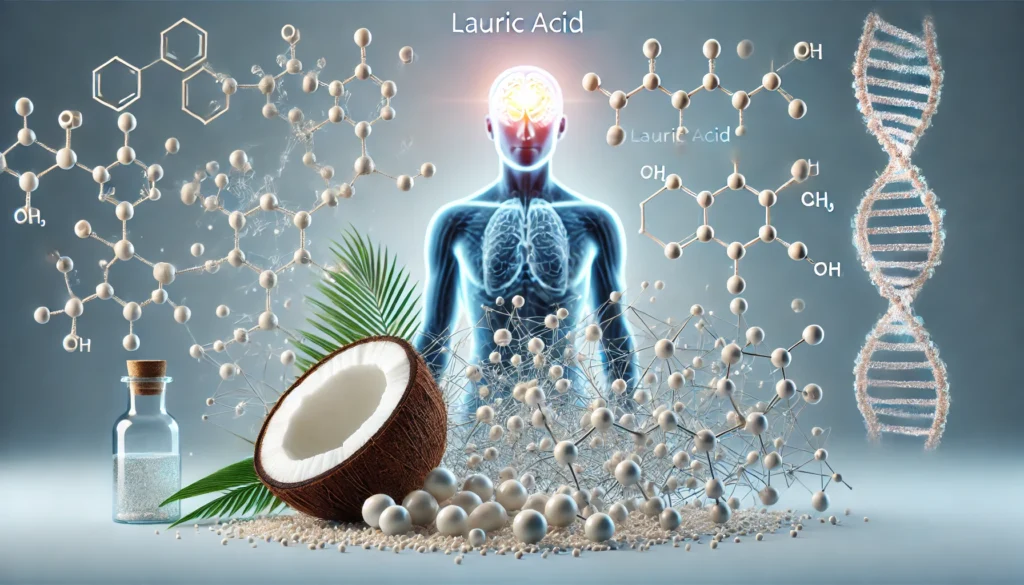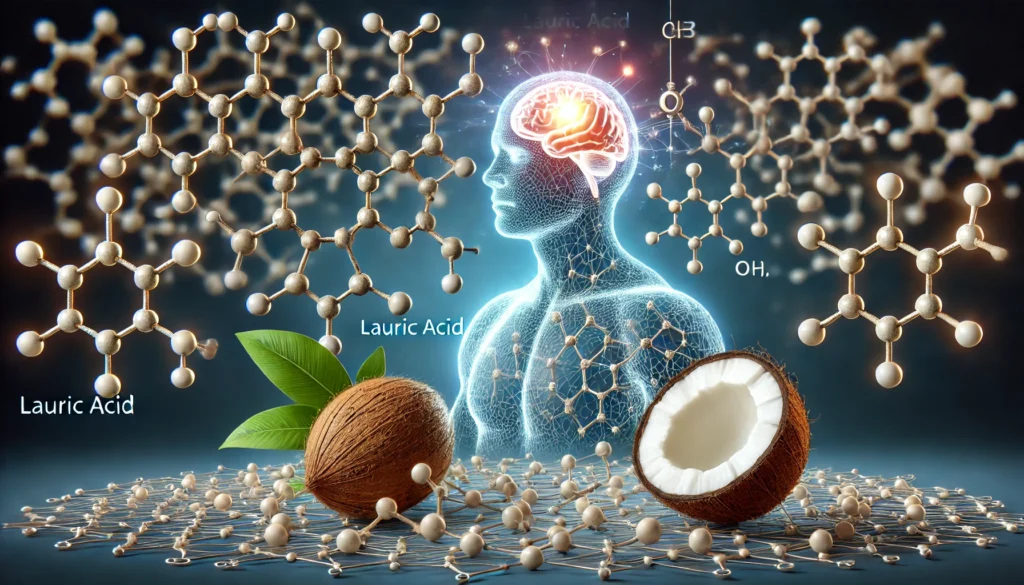Lauric acid (C12:0) is a saturated medium-chain fatty acid (MCFA) found predominantly in coconut oil, palm kernel oil, and dairy products. It has garnered attention for its potential health benefits, including antimicrobial, antiviral, and anti-inflammatory properties. More recently, researchers have begun exploring its potential as a nootropic supplement due to its effects on brain function, energy metabolism, and neuroprotection. This article provides an in-depth analysis of lauric acid, covering its sources, chemistry, physiological mechanisms, nootropic potential, dosage considerations, side effects, interactions, and risks for specific populations.
You May Also Like:
Ginkgo Biloba: Benefits, Dosage, Side Effects, Drug Interactions, And Other Important Information
Sources of Lauric Acid
Lauric acid is naturally found in various dietary sources, including:
- Coconut Oil: The richest natural source, containing approximately 45-53% lauric acid.
- Palm Kernel Oil: Another significant source, with lauric acid making up about 45-50% of its fatty acid content.
- Human and Bovine Milk: Breast milk contains lauric acid as a key fatty acid, playing a crucial role in infant immune defense.
- Dairy Products: Cheese, butter, and cow’s milk provide smaller amounts of lauric acid.
While coconut oil remains the most accessible dietary source, lauric acid supplements in purified form are also available for targeted therapeutic applications.
Chemistry of Lauric Acid
Lauric acid (C12H24O2) is a medium-chain fatty acid (MCFA) with a 12-carbon backbone. Unlike long-chain fatty acids, MCFAs are metabolized differently in the body, bypassing traditional fat digestion pathways. Instead, they are transported directly to the liver via the portal vein, where they are rapidly converted into energy or ketones.
Ketones serve as an alternative energy source for the brain, especially in conditions of glucose restriction or neurodegenerative disease. This metabolic pathway has led to speculation about lauric acid’s potential cognitive benefits.

Physiological Mechanisms of Lauric Acid in the Body and Brain
Lauric acid exerts its effects through several mechanisms:
- Ketogenesis and Brain Energy Metabolism
- MCFAs, including lauric acid, undergo rapid liver metabolism to produce ketone bodies, such as beta-hydroxybutyrate (BHB) and acetoacetate.
- Ketones provide an efficient energy source for neurons, especially in aging brains where glucose metabolism is impaired.
- Anti-Inflammatory and Neuroprotective Effects
- Lauric acid exhibits anti-inflammatory properties by modulating nuclear factor kappa B (NF-κB) signaling, reducing pro-inflammatory cytokines like interleukin-6 (IL-6) and tumor necrosis factor-alpha (TNF-α).
- Chronic neuroinflammation is a contributing factor in cognitive impairment and neurodegenerative diseases.
- The reduction in inflammatory markers may support long-term brain health and neuroprotection.
- Antimicrobial Properties and Gut-Brain Axis Influence
- Lauric acid has potent antimicrobial and antiviral properties, primarily due to its conversion into monolaurin in the body.
- Monolaurin disrupts lipid membranes of pathogens, including bacteria, fungi, and certain viruses.
- By modulating gut microbiota, lauric acid may influence neurotransmitter production, such as serotonin, thereby impacting mood and cognitive function.
Nootropic Benefits of Lauric Acid
Research on lauric acid as a nootropic is still developing, but early findings suggest it may enhance cognitive function in several ways:
- Enhanced Brain Energy and Mental Clarity
- Lauric acid aids in ketone production, providing an alternative energy source for the brain. This process may improve cognitive function and mental clarity, especially during periods of low glucose availability.
- Neuroprotection Against Oxidative Stress
- As an antioxidant, lauric acid helps combat oxidative stress, a significant factor in cognitive decline and neurodegenerative diseases. By reducing free radical damage, it may support long-term brain health.
- Potential Support for Alzheimer’s Disease
- Research indicates that ketogenic diets, which increase ketone levels from MCFAs like lauric acid, may help slow cognitive decline in Alzheimer’s patients. This effect is linked to reduced amyloid-beta plaque accumulation and improved neuronal function.
- Mood and Anxiety Regulation
- Lauric acid may positively affect neurotransmitter activity by modulating inflammation and gut microbiota. This mechanism could help reduce symptoms of anxiety and depression, supporting overall mental well-being.
Although further studies are required to confirm these benefits, preliminary research suggests lauric acid has potential neuroprotective and cognitive-enhancing properties, making it a promising option for those seeking alternative brain health support.

Dosage and Supplementation Guidelines
Lauric acid supplementation typically comes from coconut oil, MCT (medium-chain triglyceride) oil, or purified lauric acid capsules. Dosage guidelines vary depending on the intended use:
- General Cognitive Support: 5-15g daily, sourced from coconut oil or MCT oil.
- Ketogenic Benefits: 15-30g daily, often combined with other MCTs like caprylic acid (C8) for enhanced ketone production.
- Antimicrobial and Gut Health Support: 1-3g of monolaurin (a derivative of lauric acid) daily.
It is advisable to start with lower doses and gradually increase to assess tolerance.
Side Effects and Safety
Lauric acid is generally well tolerated, but potential side effects include:
- Gastrointestinal Distress: Large doses may cause bloating, diarrhea, or nausea due to rapid digestion and ketone production.
- Possible Increase in LDL Cholesterol: While MCFAs may improve HDL (good) cholesterol, they can also increase LDL (bad) cholesterol in some individuals.
- Allergic Reactions: Rare but possible, especially in individuals allergic to coconut-derived products.
Interactions with Other Supplements and Medications
Lauric acid may interact with certain medications and supplements:
- Blood Thinners (e.g., Warfarin, Aspirin)
- Coconut oil-derived lauric acid may have mild anticoagulant properties, potentially increasing bleeding risk.
- Diabetes Medications (e.g., Metformin, Insulin)
- Ketone production from lauric acid may affect blood glucose levels, requiring adjustments in diabetes management.
- Cholesterol-Lowering Drugs (e.g., Statins)
- Lauric acid may alter lipid metabolism, possibly affecting statin efficacy.
- Other Nootropics (e.g., Piracetam, Bacopa Monnieri)
- Combining lauric acid with other cognitive enhancers may have synergistic effects but should be monitored for overstimulation.
Risks for Individuals with Certain Health Conditions
Lauric acid may not be suitable for everyone. Caution is advised for:
- Individuals with Cardiovascular Disease: While some studies suggest MCFAs improve lipid profiles, others indicate they may elevate LDL cholesterol.
- People with Gastrointestinal Disorders: Conditions like IBS or SIBO may be exacerbated by lauric acid’s antimicrobial effects.
- Pregnant and Breastfeeding Women: While lauric acid is naturally present in breast milk, supplemental forms should be used cautiously due to limited safety data.
Conclusion: Should You Consider Lauric Acid as a Nootropic?
Lauric acid presents a promising yet underexplored option in the field of nootropics. Its unique ability to enhance brain energy metabolism, exert neuroprotective effects, and modulate inflammation makes it a potential candidate for cognitive enhancement. However, more clinical research is needed to establish definitive benefits and long-term safety.
For individuals seeking cognitive support, lauric acid—whether from dietary sources or supplements—may offer a natural approach to enhancing mental clarity and brain health. As always, consultation with a healthcare professional is recommended before incorporating it into a nootropic regimen.
In summary, lauric acid holds intriguing potential, but prudent use and further research are necessary to fully understand its cognitive-enhancing properties.

References:
- What Is Lauric Acid? Retrieved from: https://www.healthline.com/health/beauty-skin-care/what-is-lauric-acid
- Lauric Acid – Uses, Side Effects, and More. Retrieved from: https://www.webmd.com/vitamins/ai/ingredientmono-1138/lauric-acid
- Biomedical Applications of Lauric Acid: A Narrative Review. Retrieved from: https://pmc.ncbi.nlm.nih.gov/articles/PMC11260118/
Important Note: The information contained in this article is for general informational purposes only, and should not be construed as health or medical advice, nor is it intended to diagnose, prevent, treat, or cure any disease or health condition. Before embarking on any diet, fitness regimen, or program of nutritional supplementation, it is advisable to consult your healthcare professional in order to determine its safety and probable efficacy in terms of your individual state of health.
Regarding Nutritional Supplements Or Other Non-Prescription Health Products: If any nutritional supplements or other non-prescription health products are mentioned in the foregoing article, any claims or statements made about them have not been evaluated by the U.S. Food and Drug Administration, and such nutritional supplements or other health products are not intended to diagnose, treat, cure, or prevent any disease.


